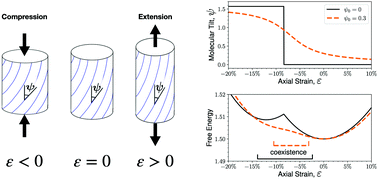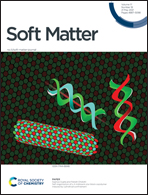Chiral phase-coexistence in compressed double-twist elastomers
Abstract
We adapt the theory of anisotropic rubber elasticity to model cross-linked double-twist liquid crystal cylinders such as exhibited in biological systems. In mechanical extension we recover strain-straightening, but with an exact expression in the small twist-angle limit. In compression, we observe coexistence between high and low twist phases. Coexistence begins at small compressive strains and is robustly observed for any anisotropic cross-links and for general double-twist functions – but disappears at large twist angles. Within the coexistence region, significant compression of double-twist cylinders is allowed at constant stress. Our results are qualitatively consistent with previous observations of swollen or compressed collagen fibrils, indicating that this phenomenon may be readily accessible experimentally.



 Please wait while we load your content...
Please wait while we load your content...